Planck's first glimpse at galaxy clusters and a new supercluster.
Surveying the microwave sky, Planck has obtained its very first images of galaxy clusters, amongst the largest objects in the Universe, by means of the Sunyaev-Zel'dovich effect, a characteristic signature they imprint on the Cosmic Microwave Background. Joining forces in a fruitful collaboration between ESA missions, XMM-Newton followed up Planck's detections and revealed that one of them is a previously unknown supercluster of galaxies.
Matter in the Universe is distributed in a highly clustered fashion; stars congregate in galaxies and galaxies clump together, forming enormous clusters surrounded by vast, empty spaces. Galaxy clusters can host up to a thousand galaxies and they are permeated by hot gas that shines brightly in X-rays; furthermore, most of their mass consists of dark matter. On an even grander scale are the superclusters, large assemblies of galaxy groups and clusters, located at the intersections of sheets and filaments in the wispy cosmic web. As clusters and superclusters trace the distribution of both luminous and dark matter throughout the Universe, their observation is crucial to probe how cosmic structures formed and evolved.
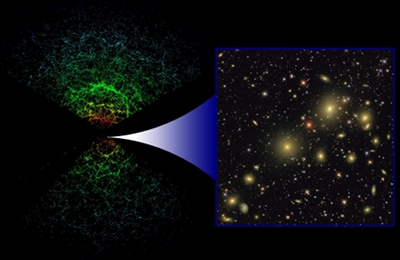 Large-scale structure in the Universe.
Large-scale structure in the Universe.
Credit: Sloan Digital Sky Survey Team, NASA, NSF, DOE.
Planck's primary goal is to capture the most ancient light of the cosmos, the Cosmic Microwave Background (CMB), and for this purpose it boasts a superb set of nine frequency channels, spanning the spectral range from 30 to 857 GHz. Such a broad spectral coverage is not only instrumental in removing all sources of contamination from the CMB, in order to deliver what will be the sharpest image of the early Universe ever achieved - it also makes Planck an excellent hunter of galaxy clusters.
In fact, the nine frequency channels were carefully chosen by the Planck team with a particular phenomenon, known as the Sunyaev-Zel'dovich Effect (SZE), very much in mind. This effect describes the change of energy experienced by CMB photons when they encounter a galaxy cluster as they travel towards us, in the process imprinting a distinctive signature on the CMB itself. Hence, the SZE represents a unique tool to detect galaxy clusters, even at high redshift.
"As the fossil photons from the Big Bang cross the Universe, they interact with the matter that they encounter: when travelling through a galaxy cluster, for example, the CMB photons scatter off free electrons present in the hot gas that fills the cluster," explains Nabila Aghanim of the Institut d'Astrophysique Spatiale in Orsay, France, a leading member of the group of Planck scientists investigating SZE clusters and secondary anisotropies. "These collisions redistribute the frequencies of photons in a particular way that enables us to isolate the intervening cluster from the CMB signal."
Since the hot electrons in the cluster are much more energetic than the CMB photons, interactions between the two species typically result in the photons being scattered to higher energies. This means that, when looking at the CMB in the direction of a galaxy cluster, one observes a deficit, with respect to the average CMB signal, of low-energy photons and a surplus of more energetic ones. The threshold frequency, separating deficit and surplus, corresponds to 217 GHz. Planck's channels probe the spectrum both below and above this threshold, with one of them centred exactly on 217 GHz.
 Multi-band observations of the galaxy cluster Abell 2319. (Click on the image for a larger version and further details.)
Multi-band observations of the galaxy cluster Abell 2319. (Click on the image for a larger version and further details.)
Credit: ESA/ LFI & HFI Consortia.
"With its unprecedented spectral coverage, Planck can detect both the positive and the negative signal of galaxy clusters, and is thus an exceptional tool to identify the locations of these enormous structures over the entire sky, and to measure their physical characteristics," says Jan Tauber, Planck Project Scientist, commenting on the first observations of the SZE in the Planck frequency bands. These first images include some clusters that are well known to astronomers, such as Coma, a very hot and nearby cluster extending over more than two degrees in the sky, and Abell 2319, another nearby cluster.
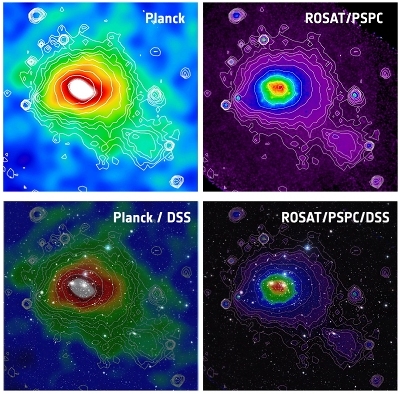 The Coma cluster as it appears through the Sunyaev-Zel'dovich Effect (top left) and X-ray emission (top right). The images are superimposed on a wide-field view of the region from the Digitised Sky Survey (lower two panels). (Click on the image for a larger version and further details.)
The Coma cluster as it appears through the Sunyaev-Zel'dovich Effect (top left) and X-ray emission (top right). The images are superimposed on a wide-field view of the region from the Digitised Sky Survey (lower two panels). (Click on the image for a larger version and further details.)
Planck's design, optimised for detecting the SZE signal from clusters scattered throughout the sky, is however not suited for in-depth investigations— its resolution is simply not sufficient to discern much detail for most of them, especially any newly discovered, high-redshift ones. Observations at other wavelengths are necessary to pin down the details of these massive structures. Since the hot gas in galaxy clusters emits copious amounts of X-rays, observations in this spectral band prove particularly useful as they probe the very same component responsible for producing the SZE.
In order to confirm their identity, Planck's cluster candidates are compared with existing catalogues of clusters, like the ROSAT all-sky X-ray catalogue of clusters. When the Planck candidates do not correspond to any known structure, and after careful quality checks of the SZ signal, they may become the target of brand new, follow-up observations with ESA's X-ray observatory, XMM-Newton.
"With its exceptional sensitivity, XMM-Newton is the ideal partner to follow-up the sources detected by Planck via the SZE," says Monique Arnaud, from the Service d'Astrophysique, Commissariat à l'Energie Atomique, France, who leads the Planck group following up sources with XMM-Newton. It is the special synergy between these two ESA missions that has allowed astronomers to use snapshot XMM-Newton observations to confirm that Planck's first detections are indeed clusters, and has revealed an even larger structure: a supercluster of galaxies.
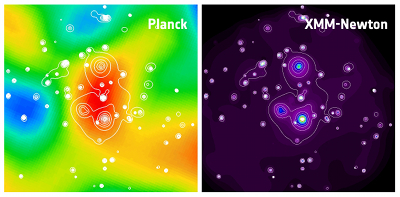 A new supercluster, seen by Planck and XMM-Newton.
A new supercluster, seen by Planck and XMM-Newton.
Credit: Planck image: ESA/LFI & HFI Consortia; XMM-Newton image: ESA.
"The XMM-Newton observations have shown that one of the candidate clusters is in fact a supercluster composed of at least three individual, massive clusters of galaxies, which Planck alone could not have resolved," explains Arnaud.
"The synergy between the two missions has proved extremely successful, and XMM-Newton will continue following up Planck detections in order to confirm the nature of the cluster candidates," says Norbert Schartel, XMM-Newton Project Scientist. In the future, XMM-Newton may conduct further, deeper observations of some of these clusters in order to measure their properties in greater detail.
"This is the first time that a supercluster has been discovered via the SZE," adds Aghanim. "This important discovery opens a brand new window on superclusters, one which complements the observations of the individual galaxies therein."
The SZ signal from the newly discovered supercluster arises from the sum of the signal from the three individual clusters, with a possible additional contribution from an inter-cluster filamentary structure. This provides important clues about the distribution of gas on very large scales which is, in turn, crucial also for tracing the underlying distribution of dark matter.
"These first detections, revealing both previously known clusters and brand new ones, show that Planck is working extremely well," comments Tauber. "Of course, this is only a preview of the numerous discoveries that will surely come along during the lifetime of the mission."
Notes for editors.
ESA’s Planck mission maps the sky in nine frequencies using two state-of-the-art instruments, designed to produce high-sensitivity, multi-frequency measurements of the diffuse sky radiation: the High Frequency Instrument (HFI) includes the frequency bands 100 - 857 GHz, and the Low Frequency Instrument (LFI) includes the frequency bands 30 - 70 GHz.
The first Planck all-sky survey began in mid-August 2009 and was completed in June 2010. Planck will continue to gather data until the end of 2011, during which time it will complete over four all-sky scans.
The Planck team is currently analysing the data from the first all-sky survey to identify both known and new galaxy clusters for the early Sunyaev-Zel'dovich catalogue, which will be released in January of 2011 as part of the Early Release Compact Source Catalogue. Companion scientific papers will accompany the catalogue.
The initial programme of follow-up observations using XMM-Newton, undertaken in Director's Discretionary Time, has the main goal of confirming the nature of a selected set of cluster candidates detected by Planck via the SZE.




. Jokes aside, it is amazing. I couldn't find anything detailing what angular area that image covered though?
 This image shows the location of the first six fields used to detect and study the Cosmic Infrared Background. The fields, named N1, AG, SP, LH2, Boötes 1 and Boötes 2, respectively, are all located at a relatively high galactic latitude, where the foreground contamination due to the Milky Way's diffuse emission is less dramatic.
This image shows the location of the first six fields used to detect and study the Cosmic Infrared Background. The fields, named N1, AG, SP, LH2, Boötes 1 and Boötes 2, respectively, are all located at a relatively high galactic latitude, where the foreground contamination due to the Milky Way's diffuse emission is less dramatic. The colour composite of the Rho Ophiuchus molecular cloud highlights the correlation between the anomalous microwave emission, most likely due to miniature spinning dust grains observed at 30 GHz (shown here in red), and the thermal dust emission, observed at 857 GHz (shown here in green). The complex structure of knots and filaments, visible in this cloud of gas and dust, represents striking evidence for the ongoing processes of star formation. The composite image (right) is based on three individual maps (left) taken at 0.4 GHz from Haslam et al. (1982) and at 30 GHz and 857 GHz by Planck, respectively. The size of the image is about 5 degrees on a side, which is about 10 times the apparent diameter of the full Moon.
The colour composite of the Rho Ophiuchus molecular cloud highlights the correlation between the anomalous microwave emission, most likely due to miniature spinning dust grains observed at 30 GHz (shown here in red), and the thermal dust emission, observed at 857 GHz (shown here in green). The complex structure of knots and filaments, visible in this cloud of gas and dust, represents striking evidence for the ongoing processes of star formation. The composite image (right) is based on three individual maps (left) taken at 0.4 GHz from Haslam et al. (1982) and at 30 GHz and 857 GHz by Planck, respectively. The size of the image is about 5 degrees on a side, which is about 10 times the apparent diameter of the full Moon. This image shows one of the newly discovered superclusters of galaxies, PLCK G214.6+37.0, detected by Planck and confirmed by XMM-Newton. This is the first supercluster to be discovered through its Sunyaev-Zel'dovich effect. The effect is the name for the cluster’s silhouette against the cosmic microwave background radiation. Combined with other observations, the Sunyaev-Zel'dovich effect allows astronomers to measure properties such as the temperature and density of the cluster’s hot gas where the galaxies are embedded. The right panel shows the X-ray image of the supercluster obtained with XMM-Newton, which reveals that three galaxy clusters comprise this supercluster. The bright orange blob in the left panel shows the Sunyaev-Zel'dovich image of the supercluster, obtained by Planck. The X-ray contours are also superimposed on the Planck image.
This image shows one of the newly discovered superclusters of galaxies, PLCK G214.6+37.0, detected by Planck and confirmed by XMM-Newton. This is the first supercluster to be discovered through its Sunyaev-Zel'dovich effect. The effect is the name for the cluster’s silhouette against the cosmic microwave background radiation. Combined with other observations, the Sunyaev-Zel'dovich effect allows astronomers to measure properties such as the temperature and density of the cluster’s hot gas where the galaxies are embedded. The right panel shows the X-ray image of the supercluster obtained with XMM-Newton, which reveals that three galaxy clusters comprise this supercluster. The bright orange blob in the left panel shows the Sunyaev-Zel'dovich image of the supercluster, obtained by Planck. The X-ray contours are also superimposed on the Planck image.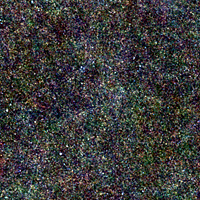
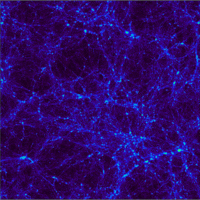
 |
|
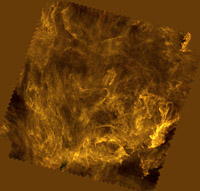 |
|
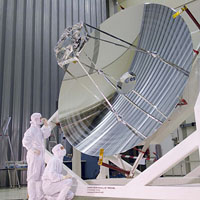 Dense filaments of gas in the IC5146 interstellar cloud. This image was taken by ESA’s Herschel space observatory at infrared wavelengths 70, 250 and 500 microns. Stars are forming along these filaments.
Dense filaments of gas in the IC5146 interstellar cloud. This image was taken by ESA’s Herschel space observatory at infrared wavelengths 70, 250 and 500 microns. Stars are forming along these filaments.